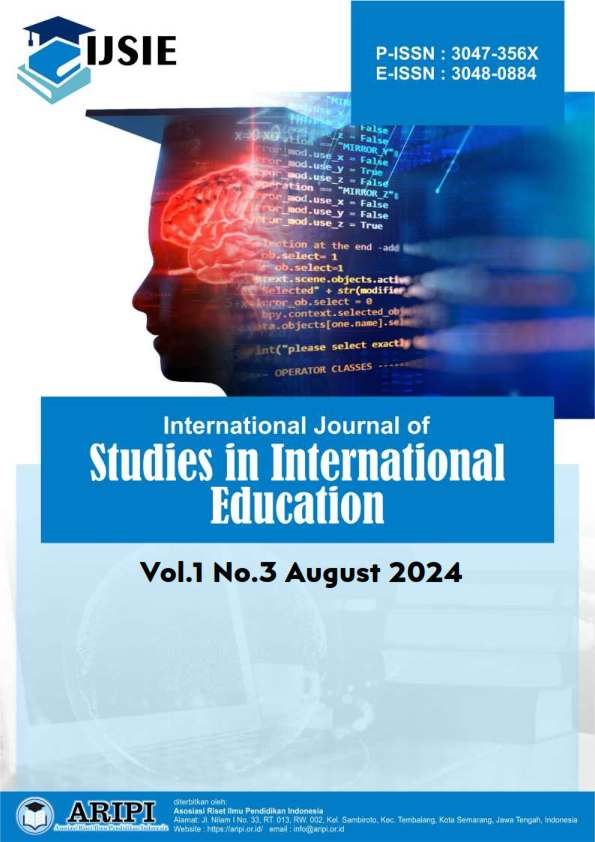Analyzing Grammatical Errors in The Undergraduate Thesis of Students of The Department of Arabic Language Education at Sultan Sharif Qasim Islamic State University Riau In 2017
DOI:
https://doi.org/10.62951/ijsie.v1i4.53Keywords:
Analysis, errors, grammar, thesis, Arabic languageAbstract
This research aims to detect grammatical errors in the undergraduate thesis of students of the Department of Arabic Language Education at Sultan Sharif Qasim Islamic State University Riau in 2017. The design of this research is a descriptive qualitative research. The data collection tools are the official documents method. In this research, the researcher analyzed the grammatical errors in the university thesis, where the researcher went through three stages, namely: 1- Recognizing the error, the researcher looked at the texts of the supplementary research written in Arabic for students of the Department of Arabic Language Education at Sultan Sharif Qasim Islamic State University in 2017, and identified the errors in which the students deviated from the grammatical rules. 2 - Correcting the error, the researcher clarified what is correct 3 - Clarifying the error, the researcher clarified what are the correct rules in the Arabic language. The results of this research are: The grammatical errors made by the students of the Department of Arabic Language Education at Sultan Sharif Qasim Islamic State University, Riau, in writing the supplementary research are many, including those related to the section of marfu’at, manshubat, majrurat, majzumat, asma` ma’rifah, tawabi’ and murakkabat. The researcher found forty-nine errors in the section of tawabi’ (na’at haqiqy) and forty errors in the section of murakkabat (tarkib idhafah). The least number of errors were found in the section of majrurat and majzumat.
References
Abdullah, O. S. (2000). Tahlil Akhtha` Lughowiyyah Tahririyyah lada Thullab Ma`had Khurtum Dauly lillughoh Arabiyyah (Analyzing the written language errors of Khartoum International Arabic Language Institute students who speak other languages). Khartoum International Arabic Language Institute.
Al-Babti, A. F. (2004). An-Nahw Al-Araby (Arabic Grammar). Dar Al-Kutub Al-Il miyya.
Al-Basha, I. K. (2002). Asrar Nahw (Secrets of Grammar) (2 ed.). Dar Al Fikr for Printing, Publishing and Distribution.
Al-Farahdi, A.-K. bin A. (2008). Mu’jam al-Ain (eye dictionary). ilmul al-Kitab.
Al-Jauhary, A. N. I. bin H. (1999). As-Shohhah (correctness). Daar Turats Araby.
Al-Jurjani, S. (2005). Kitab at-Ta’rifat (Book of Definitions). Dar Al Fikr.
Al-Razi, - Imam Muhammad ibn Abi Bakr ibn Abdul Qadir. (1994). Mokhtar as-Sahhah (Selected correctness) (1 ed.). Dar Al-Kutub Al-Ilmiyya.
Al-Saki, D. F. M. (1977). Aqsam Kalam Araby min Haitsu syakl wa wazhifah (sections of Arabic speech in terms of form and function). Khanji Bookstore.
Al-Tantawi, - Sheikh Mohammed. (1119). Nasy`at Nahw wa Tarikh Asyhur Nuhat (The origins of grammar and the history of famous grammarians). Daar el Ma’arif.
Auzy, A. (1993). Tahlil Madhmun (Content analysis and research methodology). Maaroko corporation.
El-Amin, M. I. S. and I. M. (1982). Taqabul Lughowy wa tahlil akhtha` (Linguistic correspondences and error analysis) (1 ed.). Imada Syu`un Maktabat.
El-Hashimi, A. (2010). Qowaid Asasiyya lillughoh arabiyyah (Basic Arabaic Grammar). Daar Taufiqiyya for Heritage.
Fayyad, S. (1995). Nahw ’Ashry (Modern Grammar). Ahram Centre.
Moleong, L. (2005). Qualitative Research Methodology. Remaja Rosdakarya Company.
Siraj, I. (1430). Ushul fi Nahw (Fundamental of Grammar) (1 ed.). “Tsaqofah Diniyyah” Bookstore.
Society, - Arabic Language. (2008). Mu’jam al-Wasit (al-Wasit Dictionary). Suruq Dauliyya Bookstore.
Downloads
Published
How to Cite
Issue
Section
License
Copyright (c) 2024 International Journal of Studies in International Education

This work is licensed under a Creative Commons Attribution-ShareAlike 4.0 International License.




